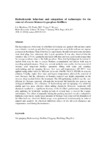Mostrar o rexistro simple do ítem
Hydrodynamic behaviour and comparison of technologies for the removal of excess biomass in gas-phase biofilters
| dc.contributor.author | Mendoza, J.A. | |
| dc.contributor.author | Prado Rubianes, Óscar Jesús | |
| dc.contributor.author | Veiga, María Carmen | |
| dc.contributor.author | Kennes, Christian | |
| dc.date.accessioned | 2014-10-23T15:28:59Z | |
| dc.date.available | 2014-10-23T15:28:59Z | |
| dc.date.issued | 2004 | |
| dc.identifier.citation | Mendoza JA, Prado ÓJ, Veiga MC, Kennes C. Hydrodynamic behaviour and comparison of technologies for the removal of excess biomass in gas-phase biofilters. Water Res. 2004;38(2):404-13 | es_ES |
| dc.identifier.other | DOI: 10.1016/j.watres.2003.09.014 | |
| dc.identifier.uri | http://hdl.handle.net/2183/13728 | |
| dc.description.abstract | The hydrodynamic behaviour of a biofilter fed toluene and packed with an inert carrier was evaluated on start-up and after long-term operation, using both methane and styrene as tracers in Residence Time Distribution experiments. Results indicated some deviation from ideal plug flow behaviour after 2-year operation. It was also observed that the retention time of VOCs gradually increased with time and was significantly longer than the average residence time of the bulk gas phase. Non-ideal hydrodynamic behaviour in packed beds may be due to excess biomass accumulation and affects both reactor modeling and performance. Therefore, several methods were studied for the removal of biomass after long-term biofilter operation: filling with water and draining, backwashing, and air sparging. Several flow rates and temperatures (20–60°C) were applied using either water or different chemicals (NaOH, NaOCl, HTAB) in aqueous solution. Usually, higher flow rates and higher temperatures allowed the removal of more biomass, but the efficiency of biomass removal was highly dependant on the pressure drop reached before the treatment. The filling/draining method was the least efficient for biomass removal, although the treatment did basically not generate any biological inhibition. The efficiency of backwashing and air sparging was relatively similar and was more effective when adding chemicals. However, treatments with chemicals resulted in a significant decrease of the biofilter's performance immediately after applying the treatment, needing periods of several days to recover the original performance. The effect of manually mixing the packing material was also evaluated in duplicate experiments. Quite large amounts of biomass were removed but disruption of the filter bed was observed. Batch assays were performed simultaneously in order to support and quantify the observed inhibitory effects of the different chemicals and temperatures used during the treatments. | es_ES |
| dc.language.iso | eng | es_ES |
| dc.publisher | Elsevier | es_ES |
| dc.relation.uri | http://dx.doi.org/10.1016/j.watres.2003.09.014 | es_ES |
| dc.subject | Air sparging | es_ES |
| dc.subject | Backwashing | es_ES |
| dc.subject | Biofilm | es_ES |
| dc.subject | Clogging | es_ES |
| dc.subject | Modeling | es_ES |
| dc.subject | Plug flow | es_ES |
| dc.title | Hydrodynamic behaviour and comparison of technologies for the removal of excess biomass in gas-phase biofilters | es_ES |
| dc.type | info:eu-repo/semantics/article | es_ES |
| dc.rights.access | info:eu-repo/semantics/openAccess | es_ES |
Ficheiros no ítem
Este ítem aparece na(s) seguinte(s) colección(s)
-
GI-BIOENGIN- Artigos [91]






